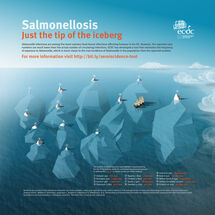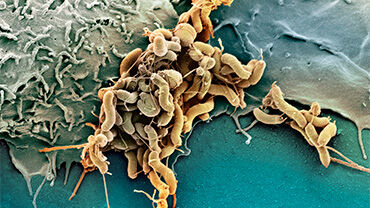Seroincidence calculator tool
The seroincidence calculator utilises the combination of serum antibody levels (lgG, lgM, and lgA) at a given point in time to estimate the time since seroconversion, which in turn gives an estimate of annual 'force of infection' in the tested population.
Download

Background
The reported number of bacterial infections such as campylobacter and salmonellosis represents only a small fraction of all cases occurring in the human population. One way to assess the total burden of these infections in humans is to measure antibody levels in serum collections. The detection of a serological response to bacterial infection can identify exposure to a pathogen even in the absence of clinical symptoms and has the potential to capture the full spectrum of infection and provide a more comprehensive overview of risk factors for exposure. Seroincidence estimates are suitable for monitoring the effect of control programmes when representative cross-sectional serum samples are available for analyses. These provide more accurate information on the infection pressure in human populations across countries then relying solely on surveillance data.
ECDC seroincidence calculator
The seroincidence calculator, funded by ECDC, utilises the combination of serum antibody levels (IgG, IgM, and IgA) at a given point in time to estimate the time since seroconversion. This in turn gives an estimate of annual ‘force of infection’ in the tested population. In order to interpret the measured cross-sectional antibody levels, parameters which predict the decay of antibodies must be known. The relationship between the three antibody levels and estimated time since infection (seroconversion) has been established in previous longitudinal studies where laboratory-confirmed cases were followed up for several months, and the decay of serum antibody levels were determined by indirect ELISA methods. (see References). A Bayesian back-calculation model was used to convert antibody measurements into an estimation of time since infection. For both the longitudinal and cross-sectional measurements of antibody concentrations, an indirect ELISA method was used.
Serological assays (ELISAs) for determination of specific antibodies IgG , IgM, and IgA were established at Statens Serum Institut (SSI) and run on a daily basis, using in-house developed, validated and accredited laboratory protocols. For Salmonella, indirect ELISA was performed on human serum using mixed LPS (lipopolysaccharide) antigens from Salmonella Typhimurium and Salmonella Enteritidis. IgA, IgM and IgG antibodies were measured individually through horseradish peroxidase (HRP)/tetramethylbenzidine (TMB) enzymatic reactions. For Campylobacter, indirect ELISA was performed on human serum using whole-cell Campylobacter jejuni antigen. The models are only valid for persons over 18 years.
The revised seroincidence calculator package provides three refinements to the method implemented in previous versions of the R package seroincidence. They are: (1) inclusion of infection episode with rising antibody levels, (2) non-exponential decay of serum antibodies after infection, and (3) age-dependent correction for subjects who have never seroconverted. In addition, the tool also provides longitudinal parameters for three additional bacterial infections; Coxiella, Pertussis and Yersinia.
Installation ECDC seroincidence R package
The seroincidence calculator tool was developed through an ECDC-funded project. To make the functionalities provided as broadly available as possible, R was chosen as the computing platform, as it is free, open source, and runs on any modern operating system.
ECDC’s seroincidence calculator is provided as an R package called seroincidence. To use an R package, R must first be installed on your computer. R is free software that can be downloaded from a CRAN mirror site, http://www.r-project.org/ . Installation guidelines for R are available in the FAQs section of the R website.
ECDC’s seroincidence package is distributed both through the CRAN network and through the ECDC website.
To install a package from ECDC, follow these detailed instructions. If you do not need the step by step tutorial, just follow the procedure below:
- Download the package:
ECDC seroincidence package (Windows only)
ECDC seroincidence package (platform-independent source version) - Open R.
- Open the Packages menu.
- Select Install package(s) from local zip files.
- Navigate to where you have saved the ECDC Zip or tar.gz file.
- Select filename and click Open.
The package must be downloaded to your computer before you can open it in R. DO NOT unpack the downloaded Zip file, it only needs to be saved on your computer.
To install the package from a CRAN mirror:
1. Open R. (instructions on installation of R)
2. Open the Packages menu.
3. Select Install package(s).
4. Select a CRAN mirror close to your location from the list.
5. Select seroincidence from the list of packages.
6. Select OK
Once the package is installed in R, it must then be loaded. A description of loading the seroincidence package is provided in the seroincidence package tutorial.
To verify the integrity of the original zip file (version 1.0.5):
MD5 checksum
1b62d7fe8c2e358545a1789a24bb6c1b
SHA1 checksum
64152ffecd3aba01ac9be4c70d70c11a029ec07c
Funding
Funding has been provided by Med-Vet-Net, a ‘Network of Excellence’ for research on the prevention and control of zoonoses, through the European Commission within the 6th Framework Programme (contract no. 506122), and by the European Centre for Disease Control and Prevention, project OJ/2009/06/03-PROC/2009/021.
A European sero-epidemiology project became Work-Package 32 of Med-Vet-Net: ‘Validation of Public Health Surveillance’. The study was funded by ECDC (ECDC 09/032/2009-2013) and builds upon the work of Med-Vet-Net.
Recent publications
Suggested citation
ECDC seroincidence R package [software application]. Version 2.0.0 Stockholm: European Centre for Disease Prevention and Control; 2018
Disclaimer: ECDC accepts no responsibility or liability whatsoever (including but not limited to any direct or consequential loss or damage it might occur to you and/or any other third party) arising out of or in connection with the installation and/or usage of this software.
Read more on the ECDC website
Multimedia
Salmonellosis - Just the tip of the iceberg
Salmonella infections are among the most common food-borne infections affecting humans in the EU. However, the reported case numbers are much lower than the actual number of circulating infections.
Read more on external websites
Kinetics of serum antibodies in response to infection with Yersinia enterocolitica
This paper describes a longitudinal study of the serum antibody response to infection with Y. enterocolitica, to provide essential information on the kinetics of serum antibodies. These allow the use of cross-sectional serum antibody measurements as biomarkers, to estimate seroconversion rates (or seroincidences).






